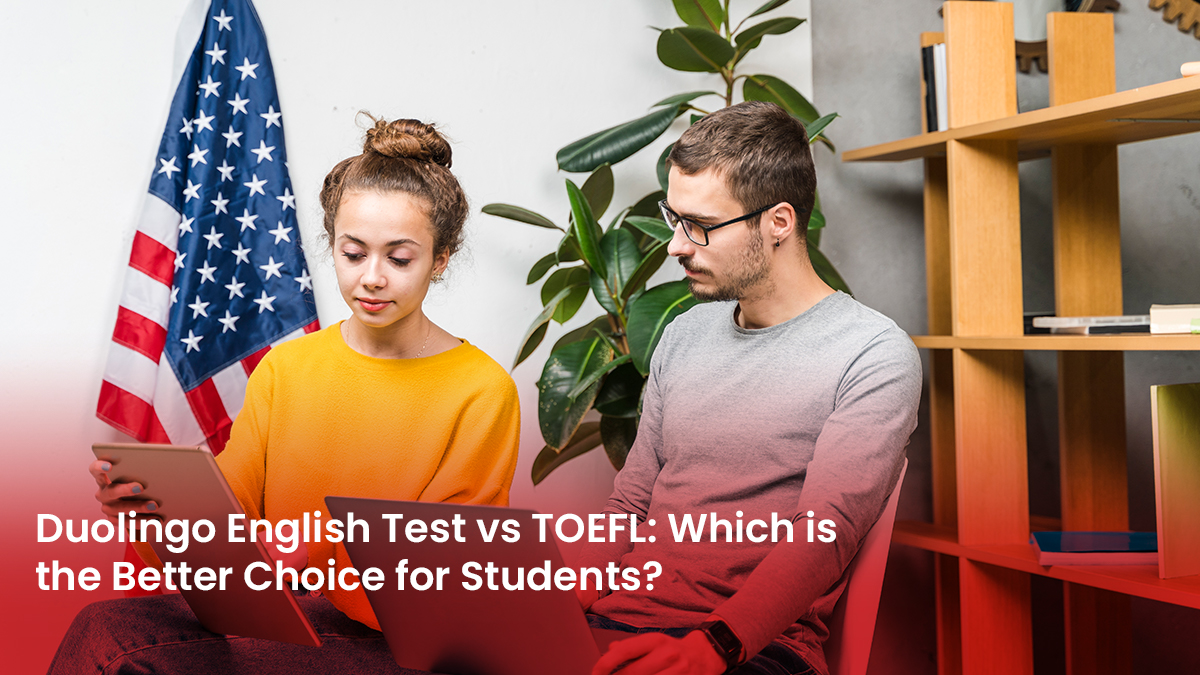In order to determine English proficiency for academic use, institutions accept scores from Duolingo and TOEFL. Duolingo provides a faster and cheaper option, while TOEFL offers a more detailed analysis of language proficiency.
The appropriate test to use will depend on factors like cost, convenience, and institutional acceptance. Each test has different strengths and weaknesses that the test-taker must consider carefully.
Knowledge of these differences helps candidates choose the test that best suits their purpose. In this MSM Unify’s blog, we will examine the major comparisons between the Duolingo English Test vs TOEFL to assist you in making an informed choice.
Understanding the Duolingo English Test and TOEFL
The Duolingo English Test (DET) and TOEFL (Test of English as a Foreign Language) are widely accepted English proficiency tests. They differ in format, duration, cost, and result timelines.
Duolingo English Test (DET)
- Format: Online, adaptive test with various tasks like multiple-choice, fill-in-the-blanks, and speaking exercises
- Duration: Takes around 45-60 minutes to complete
- Scoring system: Scores range from 10 to 160 points, aligned with the CEFR scale (A1 to C2)
- Result time: Results are provided within 48 hours
- Cost: Priced at approximately $49 USD, making it a budget-friendly option
TOEFL
- Format: Internet-based test (iBT) covering reading, listening, speaking, and writing sections
- Duration: The test lasts around 3 hours
- Scoring system: Scored on a 0-120 point scale
- Result time: Results are usually available within 6-10 days
- Cost: Costs between $185-$200 USD, depending on the country
Key differences: Duolingo English Test vs TOEFL
The Duolingo English Test (DET) and TOEFL (Test of English as a Foreign Language) differ significantly in structure, duration, and cost. Understanding these differences helps candidates choose the right test. When choosing between the Duolingo test vs TOEFL, candidates must consider these factors to select the test that best meets their needs.
Test structure and format
- Duolingo: The DET uses an adaptive format, adjusting the difficulty based on responses. It includes short questions in various formats like multiple-choice and fill-in-the-blanks
- TOEFL: TOEFL follows a fixed structure with four separate sections: reading, listening, speaking, and writing. Each section has specific question types, making the test more structured
Duration and convenience
- Duolingo: The test takes around 45-60 minutes and can be conveniently taken from home
- TOEFL: Requires a 3-hour commitment and is conducted at authorized test centers, which may be less flexible
Cost comparison
- Duolingo: Priced at $49 USD, making it an affordable option for most students
- TOEFL: Costs between $185-$200 USD, which is considerably higher
Scoring and acceptance: Duolingo English Test vs TOEFL
When comparing the Duolingo English Test (DET) and TOEFL (Test of English as a Foreign Language), understanding their scoring systems and acceptance rates helps candidates make informed decisions. Both tests are widely recognized, but their evaluation methods and global acceptance vary.
Duolingo scoring system
- Adaptive scoring: The Duolingo Test uses an adaptive system where the difficulty level changes based on the test-taker’s responses
- Score range: Scores range between 10-160 points, mapped to CEFR levels (A1 to C2).
- Competitive score: A score of 120+ on Duolingo is considered equivalent to a high TOEFL score, making it acceptable for admission to many universities
TOEFL scoring system
- Fixed scoring: TOEFL follows a structured scoring format, with four sections (reading, listening, speaking, and writing), each contributing up to 30 points.
- Score range: TOEFL scores are graded on a 0-120 scale
- Top university requirement: Competitive universities typically require a score between 90-100 for admission
Acceptance and recognition
- TOEFL: Traditionally the preferred choice for most institutions worldwide
- Duolingo: Gaining global acceptance with over 4,000 universities now recognizing its scores, including top institutions in the USA, Canada, and Europe
Pros and cons: Duolingo English Test vs TOEFL
When comparing Duolingo English Test (DET) and TOEFL, understanding their advantages and disadvantages can help candidates choose the right test.
Advantages of Duolingo
- Faster results: Results are available within 48 hours
- Lower cost: Duolingo is affordable, priced at just $49 USD
- Flexibility: The test can be conveniently taken from home
Advantages of TOEFL
- Established reputation: Accepted by over 11,000 institutions globally
- Comprehensive evaluation: Offers a thorough assessment of all language skills
Disadvantages of Duolingo
- Limited recognition: Not all universities accept Duolingo scores
- Adaptive format challenges: Adaptive testing may feel unpredictable for some test-takers
Disadvantages of TOEFL
- Higher cost: The test is expensive, costing around $185-$200 USD
- Time-consuming: TOEFL takes 3 hours and requires visiting an authorized test center
Duolingo English Test vs TOEFL: Which is easier?
Many students wonder, “Is the Duolingo test easier than TOEFL?” While Duolingo offers a more flexible and less stressful experience, its adaptive nature can be challenging for some. TOEFL is lengthier and more structured but offers more predictable question types.
Factors to consider when choosing between Duolingo and TOEFL
- University requirements: Check if the target institution accepts Duolingo or TOEFL
- Budget and time constraints: Duolingo is quicker and more affordable
- Test format preference: Choose based on your comfort level with adaptive or traditional formats
- Global recognition: TOEFL is widely accepted globally
Conclusion
Choosing between the Duolingo English Test vs TOEFL depends on individual preferences, budget, and university requirements. Duolingo offers a faster, more affordable, and flexible option, while TOEFL remains a widely accepted and comprehensive assessment.
Understanding these differences helps candidates make an informed decision based on their goals. MSM Unify overseas education consultants can assist students in identifying which test aligns with their target institutions.
Whether opting for Duolingo or TOEFL, ensuring that the test meets admission criteria is essential for a smooth application process. MSM Unify provides expert guidance to help students navigate these choices effectively.
FAQs
- Which test is easier, Duolingo or TOEFL?
The Duolingo English Test is considered easier due to its adaptive format and shorter duration. TOEFL, however, provides a more structured evaluation, which some institutions prefer.
- How long does it take to get results for Duolingo and TOEFL?
Duolingo provides results within 48 hours, making it a quicker option. TOEFL results usually take 6-10 days, which may be ideal for candidates planning in advance.
- Is the Duolingo English Test accepted by all universities?
Duolingo is accepted by over 4,000 universities worldwide, but some institutions may still prefer TOEFL scores. MSM Unify overseas education consultants can assist in verifying specific requirements.
- Which test is more affordable?
Duolingo is more budget-friendly, costing around $49 USD, while TOEFL costs between $185-$200 USD. This makes Duolingo an economical option for many students.
- Can I take Duolingo and TOEFL from home?
Duolingo offers the convenience of taking the test from home using a computer and internet connection. TOEFL iBT also offers a home edition, with strict monitoring protocols in place.



























